Second poem in the ‘Black and White, Wild and Wooly’ series for World Rhino Day - ‘Into the White’, Northern White Rhino (Ceratotherium simum cottoni).
This was a hard poem to write based on a hard image to see - Ami Vitale’s haunting image of the last goodbye to Sudan, the last male Northern White Rhino. The name of the poem came easily, but the rest resisted all attempts for maybe 18 months. A couple of weeks ago I made the upcoming World Rhino Day a deadline to finish and publish it as part of this series.
My commentary is in the poem. Here is Ami’s (from her Instagram account)…
‘Saying goodbye to Sudan was one of the hardest moments of my life. On that day in March, 2018, we were witnessing not just the death of this majestic creature and the functional extinction of a subspecies, but also watching our own demise. We need to start recognising that our fate is linked to the fate of animals. Without Rhinos and all wildlife, we will suffer more than the loss of ecosystem health. We will suffer a loss of our own imagination, a loss of wonder, a loss of beautiful possibilities. I hope that this moment will mark a moment when humanity recognises how interconnected we all really are.’
Efforts are underway to rescue the species through genetic science, and several embryos have been achieved, with a view to one day finding a surrogate Southern White Rhino to re-establish the Northern White subspecies. If it does not succeed, there are only the two ageing daughters of Sudan still alive - Naijin and Fatu, being cared for and guarded by Ol Pejeta - functionally extinct and awaiting the inevitable.
Ami has made a film about Sudan - find details and the story of ‘The Last Goodbye’ on her website
#intothewhitepoem
#NorthernWhiteRhino #functionallyextinct
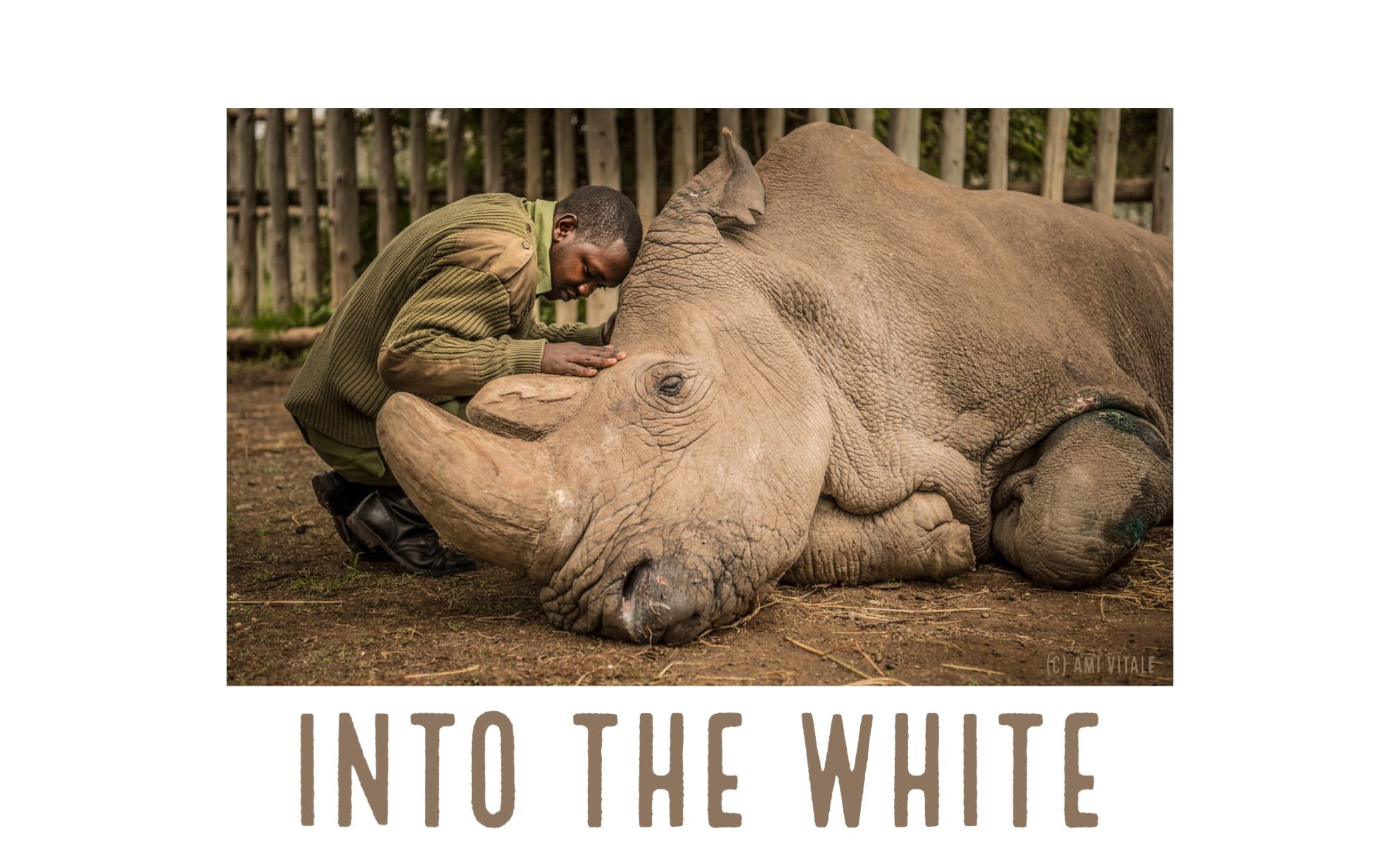
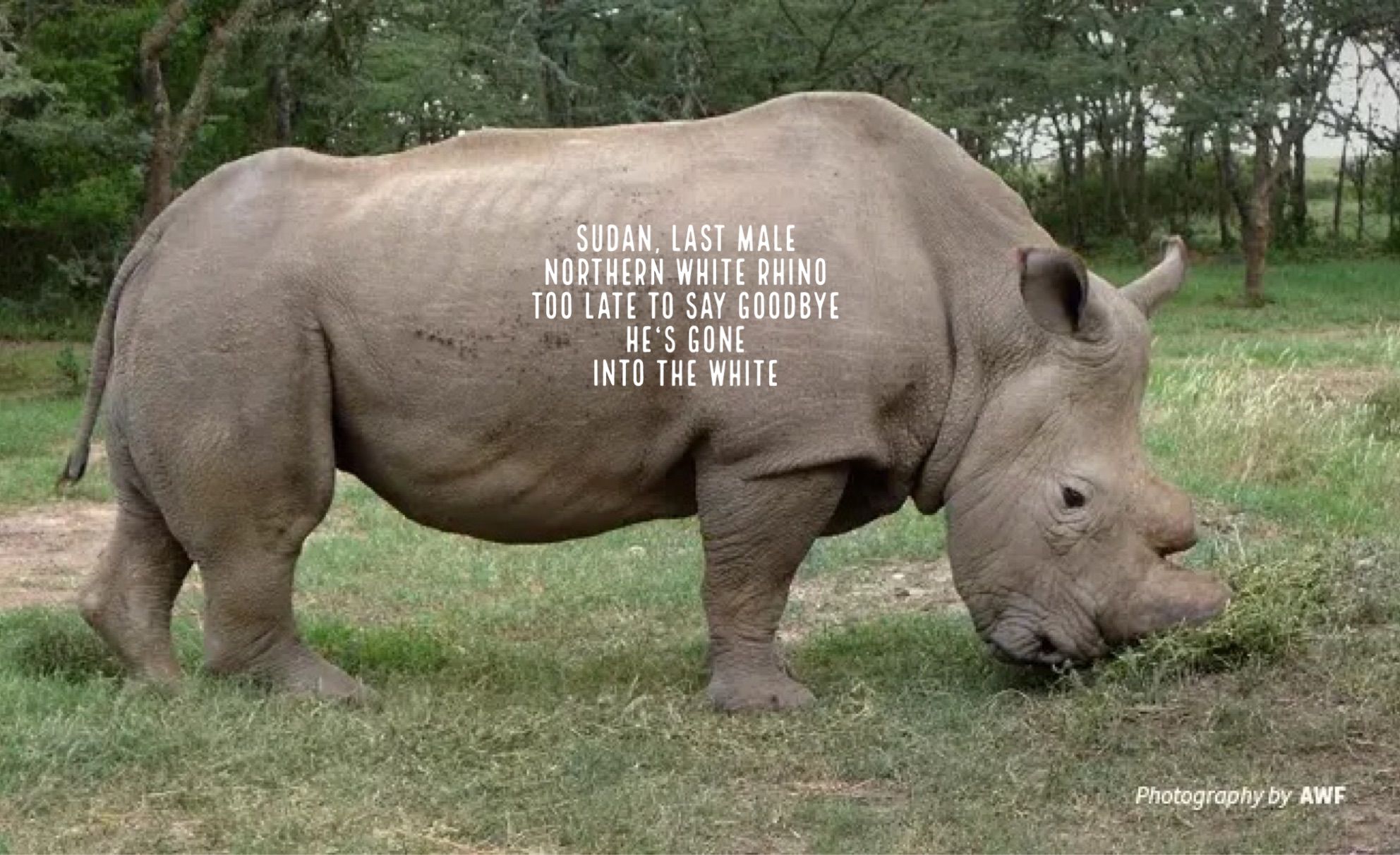
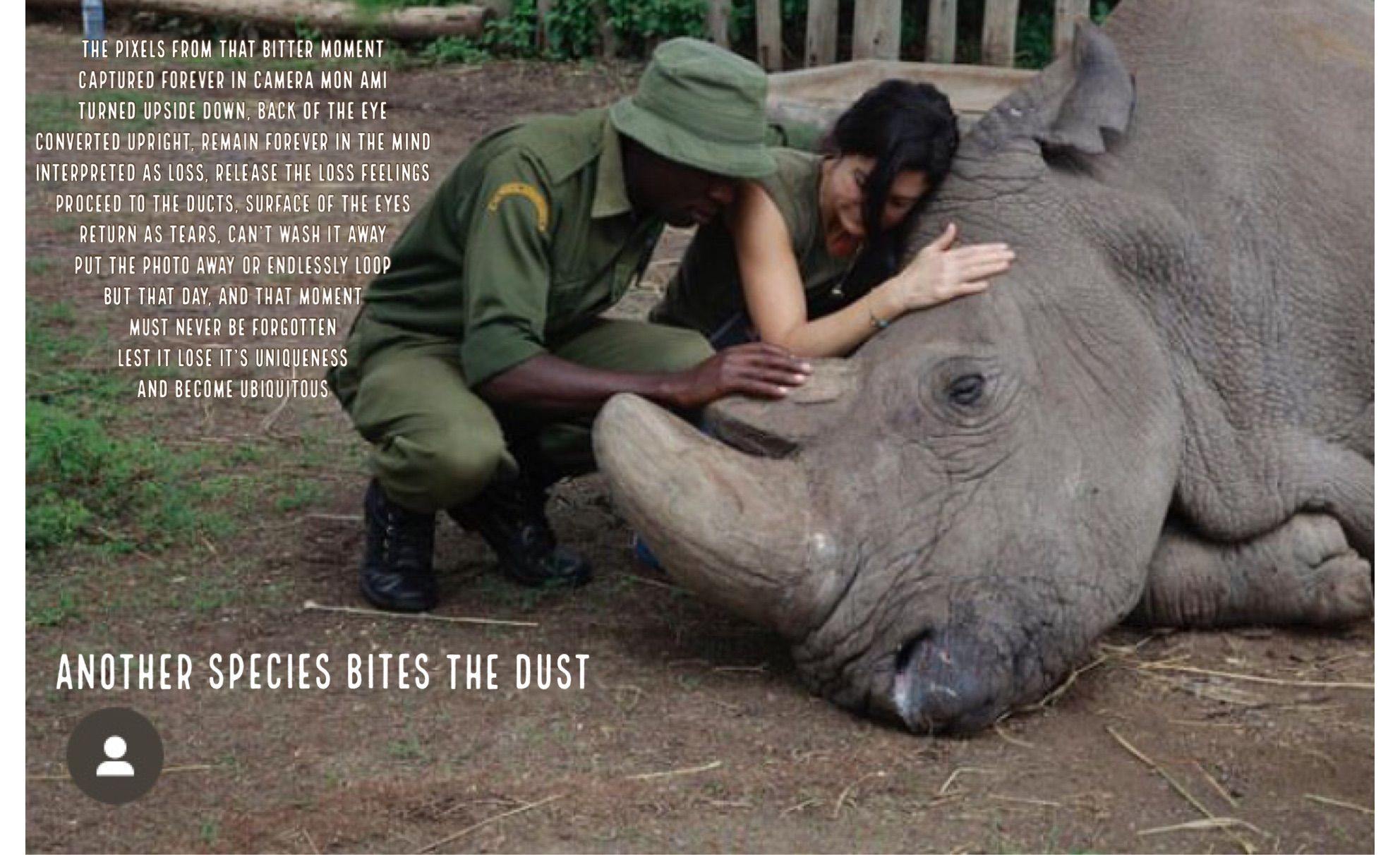
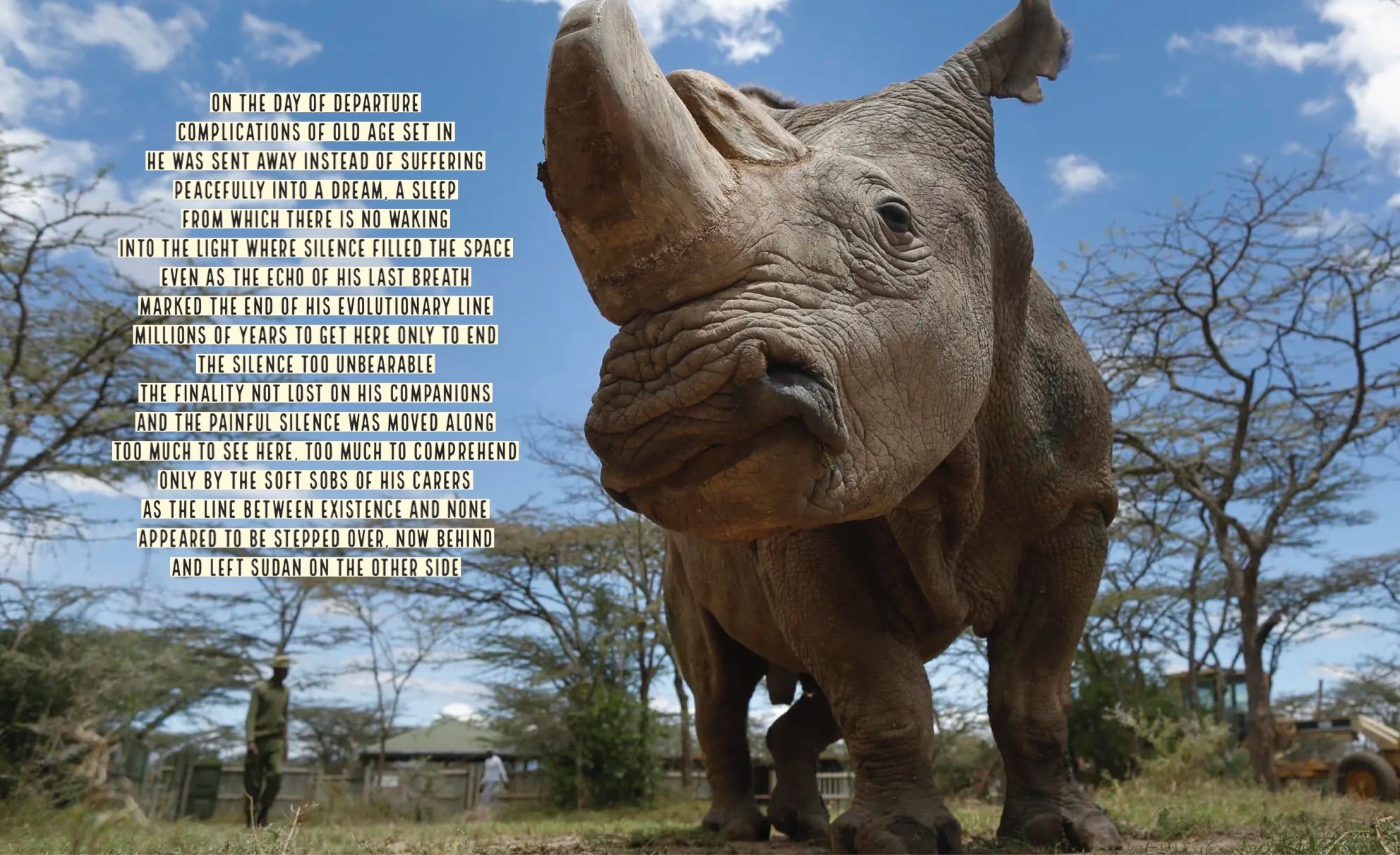
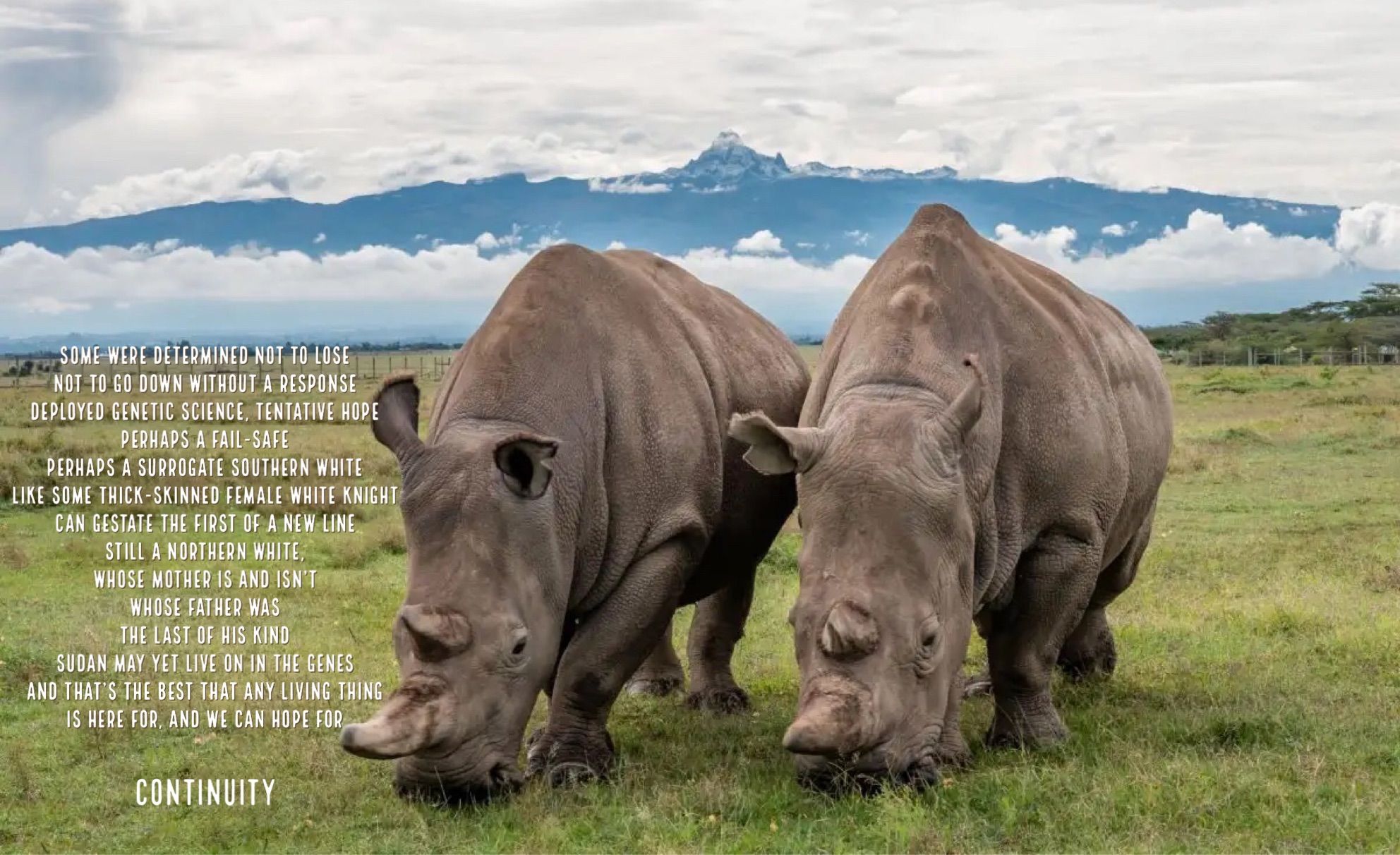

https://www.cpr.org/2015/01/28/tiger-skins-and-rhino-horns-can-a-trade-deal-halt-the-trafficking/
Within its 16,000-square-foot (1,486 square meters) confines are 1.5 million specimens, mostly products made from some of the world’s most critically endangered mammals and reptiles. Are you rubbing your eyes? Are you thinking that you must have read that wrong or are you accusing me of a typo? It is this work by the U.S Fish and Wildlife that scares the HELL out of Safari Club International and this is why SCI does corrupt things and they are trying to work around such. Trophy Hunting exotics and endangered species is one way they obtain billions of dollars. This is why they are good at paying people at the border to turn a blind eye. I will make note that not all members of the SCI are bad as many are caught up in their lies and conspiracy theories. It is my goal to go after the head honchos of the organization. To bring light onto the organization.
While the United States is not considered a major source of illegal wildlife products, it is one of the world's largest consumers of wildlife products, including exotic pets, ivory, and other wildlife goods. Here's how the USA ranks with wildlife crime and corruption:
There are gaps and relaxed laws along with things not being enforced – just because there is an “act” doesn’t mean it is being utilized to its fullest – It can portray how criminals exploit gaps in the law. The Republican party also contributes to wildlife crime because they have little to no desire to protect wildlife, hell many people in this party do not believe in Climate change. That alone speaks volumes. I am not saying all Republicans but as a party in whole they have proven this with legislation.
Here is another article :
https://www.nytimes.com/2014/09/05/t-magazine/animal-trafficking-black-market.html
The trade in illegal wildlife is a $19 billion annual business with ties to the Russian mob and Islamic extremists, and there’s one place the world turns to investigate the crime: a federal forensics lab (and curiosity cabinet) in a hippie town in Oregon. U.S. Fish and Wildlife Forensics Service Laboratory in the United States. It is located in Ashland, Oregon, and is operated by the U.S. Fish and Wildlife Service. This laboratory serves as the only federal crime laboratory dedicated to investigating wildlife-related violations of U.S. laws.
Sad not only do we have the 16,000 Sq Ft building filled with over million species/trophies, we also have this building filled as well!
We need and must provide more funding to such organizations that fight wildlife crime!
We even have conservationists, law enforcement, NGO’s, The US Fish and Wildlife (some divisions and/or individuals) who receive payouts, financial support. What should you do before supporting such NGO’s etc... If you find such organizations or individuals receiving money from the Safari Club International, NRA etc then you need to question this and do research before supporting such causes that seems to be legit when really, they are a smoke screen. They are puppets and are being controlled, being watched which all in return helps the bad people’s cause. These people do a WONDERFUL job of keeping their enemies close. So, I do agree some people are naïve and do not understand why they are receiving financial support. I once brought it to the attention of a Texas wildlife activist, filmmaker who was receiving financial support from an organization called Wildlife Partners, LLC who lie to people about their cause, and how it is about preserving and saving wildlife and how they support conservation. It is all a smoke screen. Their cause is making billions of dollars in profit from enclosed trophy hunting (ranches), so people do not have to travel to Africa to go trophy hunting. ALL about being powerful and 110% about being filthy rich. You can find their financials online. I encourage people to do their part and investigate yourself. Right now, all you can say to me is it is my “opinion”. Correct it is my opinion based on my research.
SOOO do your research- do your part.
We must spread awareness and have stricter laws because this is a global security risk and not to mention a public health risk.
At airports, seaports, and land border crossings in 2019, $4.3 billion of legal wildlife and wildlife products was imported into the U.S. Approximately 200 million live animals are imported to the U.S. annually, according to a five-year trade report: 175 million fish for the aquarium trade, and 25 million animals comprised of an array of mammals, amphibians, birds, insects, reptiles, spiders, and more. On top of that, thousands of illegally traded shipments of wildlife are intercepted each year. In 2019 alone, the agency opened more than 10,000 illegal wildlife trade investigations. Here is the kicker: Are you ready for this!
With few exceptions, the U.S. has no laws specifically requiring disease surveillance for wildlife entering the country, and the vast majority of wild animal imports are therefore not tested- Reread those numbers above and can you honestly say to me that you are okay with this? You feel safe?
It does not take an idiot to realize with these numbers that one organization like US Fish and Wildlife can handle these numbers - the start to solving this issue is to give them more funding and entice the younger generation to go into this line of work!
We are also destroying our ecosystem, which destroys the future of upcoming generations, and most people are just sitting back believing these people’s lies and allowing them to become multi-billionaires on our behalf. Are you going to allow this shit to happen? That is my question for the week.
One person can make a difference just look and learn from Ofir Drori. Therefore, it is in each and everyone of us - one person doing a little can bring upon big change.
As of my last update in September 2021, I can provide information on some of the significant wildlife crime and corruption arrests that had taken place up until that time. Please note that the rankings and details might have changed since then. Here are ten notable cases:
Please note that wildlife crime and corruption are ongoing problems, and many more arrests have likely occurred since my last update. The fight against wildlife trafficking and corruption requires ongoing efforts and collaboration from governments, law enforcement agencies, and conservation organizations worldwide.
Who are the ringleaders?
It's important to note that wildlife crime operates as a highly organized and lucrative black market, involving not only local poachers but also international syndicates. Some of the main players in wildlife crime may include:
It's worth mentioning that efforts to combat wildlife crime involve not only local law enforcement agencies but also international collaborations and organizations dedicated to wildlife conservation and law enforcement. These criminal networks are persistent and adaptive, making it crucial to address the issue through a combination of law enforcement actions, public awareness, and international cooperation. Join our fight - by learning more at https://www.mojostreaming.com/index.php
Sign up: https://www.mojostreaming.com/signup
Thank you for your interest!
Cami Ciotta VP of Development and Producer
1: How is climate change affecting wildlife?
The world we live in is changing at an alarming rate, and perhaps the most concerning change of all is climate change. This global phenomenon not only affects our environment but also has a profound impact on the wildlife that inhabits it. From rising temperatures to extreme weather events, animals are facing unprecedented challenges in their struggle for survival. In this blog post, we will delve into how climate change is affecting wildlife and what steps we can take to protect these precious creatures from its devastating effects. Join us as we explore the interplay between climate change and our beloved animal kingdom!
To join a community of wildlife enthusiast visit MojoStreaming
2: What species are affected most from climate change?
The impact of climate change on wildlife is far-reaching, but certain species bear the brunt of its effects more than others. One such group is polar bears, whose icy habitats are rapidly melting due to rising temperatures. These majestic creatures rely on sea ice for hunting and raising their young, but with the Arctic ice diminishing at an alarming rate, their survival is under threat.
Similarly, coral reefs around the world are suffering immensely from warming ocean temperatures caused by climate change. Corals depend on a delicate balance of factors to thrive, including specific water temperatures. As these conditions shift, corals experience bleaching events that can lead to mass die-offs and irreparable damage to these vital ecosystems.
Another vulnerable species is the Adélie penguin found in Antarctica. With shrinking ice cover affecting their access to food sources like krill and fish, populations have been declining rapidly in recent years.
Birds migrating across vast distances also face challenges as climate patterns shift dramatically along their routes. Changes in temperature and availability of food can disrupt migration patterns and put immense stress on already threatened bird populations.
These examples represent just a fraction of the many species impacted by climate change. The consequences extend beyond individual animals; they affect entire ecosystems upon which countless other organisms rely for survival. Understanding which species are most affected allows us to prioritize conservation efforts and take action before it's too late for our precious wildlife counterparts.
3: How do animals survive forest fires?
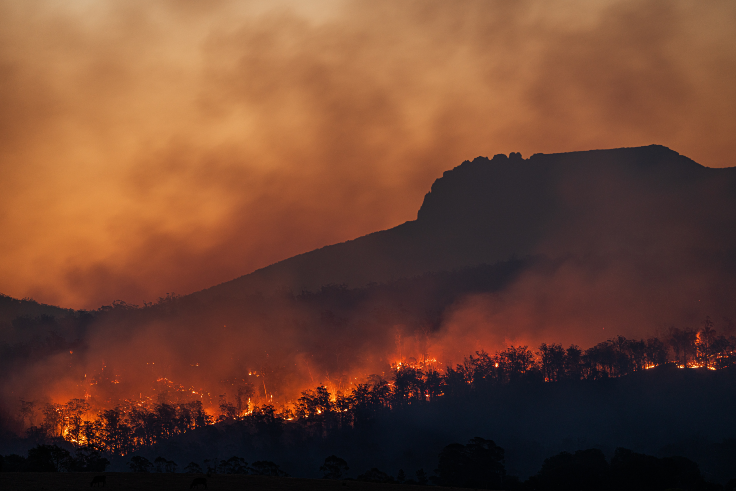
Forest fires can be devastating, not only for humans but also for wildlife. These fierce blazes can destroy habitats and force animals to flee from their homes in search of safety. So, how do animals manage to survive such a destructive force?
Some species have developed extraordinary adaptations that help them endure forest fires. Take the black-backed woodpecker, for example. This remarkable bird is well-equipped to handle post-fire environments because it feeds on insects found in burned trees.
Other animals rely on their agility and speed to escape the flames. Deer, rabbits, and squirrels are known for their ability to quickly navigate through burning forests and find refuge in safer areas.
Burrowing creatures like groundhogs or gophers have an advantage during wildfires as they retreat underground where the heat is less intense.
Additionally, certain species have evolved with fire-resistant characteristics. Plants like some pines produce cones covered with resin that protects seeds from fire damage until conditions become suitable again for growth.
While many animals can adapt or escape forest fires, large-scale infernos pose a great threat to all wildlife populations. The loss of habitat and food sources makes it challenging for these creatures to recover after such catastrophic events.
Preventing forest fires through responsible human behavior is crucial in preserving wildlife habitats. Proper land management practices such as controlled burns can even benefit certain ecosystems by reducing fuel loads and promoting biodiversity.
In conclusion (not concluding), while some animals possess unique abilities allowing them to survive forest fires, the increasing frequency and intensity of these disasters due to climate change make it imperative that we take action now before more lives are lost – both human and animal alike!
4: How do we help wildlife survive climate change?
Climate change poses significant challenges to wildlife around the world. As temperatures rise and ecosystems shift, many species struggle to adapt to these rapid changes. So how can we help them survive in this changing environment?
One crucial step is preserving and restoring habitats. By protecting natural areas such as forests, wetlands, and coral reefs, we provide essential shelter and food sources for wildlife. Restoring degraded habitats can also help create more resilient ecosystems that are better equipped to withstand climate impacts.
It's also important to reduce our carbon footprint. By decreasing greenhouse gas emissions through cleaner energy sources and sustainable practices, we can slow down the rate of climate change itself. This not only benefits wildlife but also helps preserve the delicate balance of our planet's ecosystems.
Furthermore, promoting sustainable agriculture practices is vital for both human survival and wildlife conservation. Encouraging methods that minimize deforestation, soil erosion, and chemical use can protect habitats while ensuring a stable food supply for all creatures.
Collaboration between governments, organizations, scientists,
and communities is key in implementing effective conservation strategies.
By sharing knowledge and resources,
we can develop proactive plans that prioritize the needs of vulnerable species
and ensure their continued survival in a changing climate.
Ultimately though,
the future of wildlife relies on our ability
to address the root cause of climate change.
By taking collective action at every level - from individual choices
to international agreements - we have the power
to mitigate its effects on our precious biodiversity.
Let us remember that when it comes to helping wildlife survive climate change,
every little effort counts.
Together,
we can make a difference
for the sake of our planet’s incredible biodiversity
5: What kind of impact is climate change currently having on our wildlife?
Climate change is wreaking havoc on our wildlife, causing a multitude of negative impacts. Rising temperatures are altering ecosystems and disrupting the delicate balance that many species rely on to survive. For example, as temperatures increase, sea levels rise and coastal habitats such as mangroves and coral reefs are being destroyed. This directly affects marine life like fish, turtles, and seabirds who depend on these habitats for food and shelter.
Not only that but climate change is also causing more frequent extreme weather events such as hurricanes, droughts, and floods. These events can have devastating consequences for wildlife populations. Forest fires are becoming more intense and widespread due to drier conditions caused by climate change. Animals that cannot escape in time often perish in these fires.
Moreover, changes in precipitation patterns affect the availability of water sources which can lead to dehydration and famine among animals. Species with specialized diets or specific breeding requirements may struggle to find enough food or suitable nesting sites due to shifts in plant growth patterns caused by changing climates.
Climate change poses a significant threat to our wildlife's survival. Urgent action must be taken at both individual and collective levels if we want to protect the incredible biodiversity found across the globe from further harm caused by human-induced climate change
Do you Love Wildlife watch our library of short videos, documentaries, and more at watch wildlife content
6: What does the future look like for our wildlife if we do not combat climate change?
The future of wildlife hangs precariously in the balance as we continue to ignore the urgent need for action on climate change. If we fail to combat this global crisis, our beloved animals will face unprecedented challenges that threaten their very existence.
Rising temperatures and erratic weather patterns are wreaking havoc on ecosystems around the world. With each passing year, we witness more frequent and intense heatwaves, droughts, floods, blizzards, and mudslides. These extreme events not only destroy habitats but also disrupt crucial breeding cycles and migration patterns.
As temperatures soar, many species find themselves trapped in a hostile environment where they struggle to find food and water sources. The loss of biodiversity could be catastrophic as delicate ecosystems collapse under the strain.
For marine life, warming oceans pose a grave threat. Coral reefs are already suffering from bleaching events due to rising sea temperatures - an alarming reminder of how fragile these underwater wonders truly are.
Climate change also exacerbates existing threats such as deforestation and poaching by pushing vulnerable species further towards extinction. Without immediate action to curb greenhouse gas emissions and protect natural habitats, iconic creatures like polar bears or elephants may become mere memories within our lifetimes.
The consequences extend beyond individual species; entire ecosystems are at risk of unraveling if climate change continues unchecked. The interconnectedness between plants, animals, insects - every living organism - ensures that any disruption has far-reaching implications for all life forms involved.
But it's not too late to make a difference! By embracing renewable energy sources, implementing sustainable practices in agriculture and industry, supporting conservation efforts worldwide, and advocating for stronger environmental regulations from governments globally; we can still turn the tide.
We owe it to future generations – both human and animal – to act now before it is too late. Together with concerted efforts from individuals, families, governments, businesses, and organizations; we have hope that our wildlife can thrive once again amidst a changing climate.
It is time to work together and prioritize the preservation of our precious planet and its magnificent
Our planet and the animals that live on it are magnificent - check out the beauty by visiting Our Wildlife Photo Gallery
7: What organizations and political parties are the biggest threat with fighting climate change?

When it comes to fighting climate change, there are certain organizations and political parties that pose significant challenges. While many groups are actively working towards solutions, some have been resistant or slow to acknowledge the urgency of the issue.
One organization that has faced criticism for its stance on climate change is the fossil fuel industry. With their vested interests in maintaining profits from oil, gas, and coal extraction, these companies often lobby against regulations that would limit greenhouse gas emissions. Their influence extends to political campaigns as well, where they contribute significant sums of money to candidates who align with their agenda.
In addition to the fossil fuel industry, certain political parties have also hindered progress in combating climate change. Some conservative parties tend to prioritize economic growth over environmental concerns and may be skeptical about the science behind climate change. This skepticism can lead to policies that undermine efforts to reduce carbon emissions and transition towards renewable energy sources.
It's important to note that not all organizations or political parties fall into this category. Many environmental advocacy groups work tirelessly to raise awareness about climate change and push for policy changes at local, national, and global levels. Likewise, some progressive political parties have made addressing climate change a core part of their platforms.
Addressing climate change requires collaboration across sectors and ideologies. It's crucial for both public pressure and effective leadership from governments around the world if we want meaningful action taken on this pressing issue.
MojoStreaming is a platform like no other that takes on challenges such as poaching, trophy hunting, and political parties that cause a threat to the future of our wildlife. Watch our talk shows and debates at Watch HERE
Finally: What is the first and most important thing we can do to prevent climate change?
The first and most important thing we can do to prevent climate change is to take action now. We cannot afford to wait any longer. Every individual has a role to play in this global issue.
One of the simplest ways we can make a difference is by reducing our carbon footprint. This includes making small changes in our daily lives, such as using energy-efficient appliances, driving less or carpooling, and conserving water and electricity.
Furthermore, supporting renewable energy sources like solar and wind power can have a significant impact on reducing greenhouse gas emissions. By advocating for clean energy policies and investing in sustainable technologies, we can help shift towards a greener future.
Additionally, it's crucial that we educate ourselves and others about the importance of protecting our environment. By raising awareness about the consequences of climate change on wildlife and ecosystems, we can inspire more individuals to join the fight against it.
Holding governments accountable for their environmental policies is essential. Supporting politicians who prioritize climate action will ensure that necessary regulations are put in place to mitigate the effects of climate change on wildlife.
Remember: every action counts! Together, we have the power to protect our planet’s precious biodiversity from further harm caused by climate change. Let us act now so that future generations may experience a world teeming with diverse wildlife thriving under stable climatic conditions.
Be sure to visit the sign up page and become a subscriber!
Great news to read that the House of Lords is to back the ban on trophy hunting imports into the UK (Saturday Mirror June 17th).
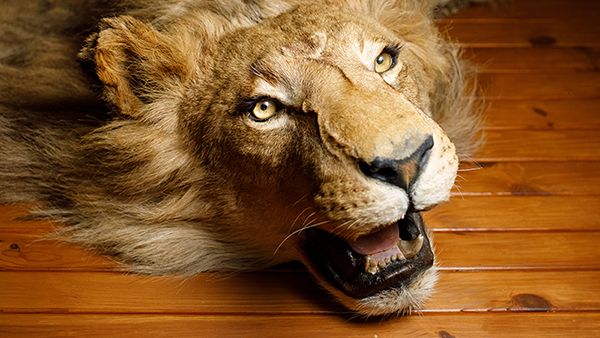
What planet is Crossbencher Lord St John of Bletso on?, who in his ignorance supports the bill, and comments “ Evidence shows properly regulated wild trophy hunting does play an important role in wildlife conservation”.
Certainly not in Zimbabwe M’Lord! – as a former Chief Inspector for the Zimbabwe National Soc. For the Prevention of Cruelty to Animals (ZNSPCA), I saw first hand how funding that was supposed to be given to the local communities where hunts took place, was rarely received by them.
Instead due to rampant corruption, it was the Town Councillors who were seen driving around in 4x4s and Mercedes, while the local villagers got nothing, except possibly some meat from the hunts.
In addition, some of the trophy hunters who visit Zimbabwe are also guilty of unethical practices, such as using donkeys and goats as live bait.
In addition, there are still several trophy hunters who are using packs of imported hounds to hunt Zimbabwean leopards which was illegal under Zimbabwe’s Wild Life Act.
I know because I was responsible for getting an Amendment to the Act making it illegal for hunters to use packs of dogs - only for the USA’s notorious Safari Club International to swiftly “persuade” the Zimbabwean Govt to make hunting with dogs “legal” again.
This practice is disliked by many professional hunters, who say that “the leopard does not stand a chance”, one Zimbabwean hunter who did use dogs for his clients, when questioned in an interview as to whether this method was ethical? - replied “it may be cruel”
Pro Trophy Hunting activists should be aware that several hunting safaris in Zimbabwe still offer this practice to their rich overseas clients, who pay extra if packs of dogs are used.
However, if a local Zimbabwean living in the rural areas, is caught hunting with his own indigenous dogs to catch rabbits and small animals to feed his family – the Zimbabwean Government’s Police shoot his dogs, he is arrested, taken to court and fined, with the possibility of being jailed if he has no money for the fine, which is more often the case............talk about double standards.
.
May I suggest that Lord St John of Bletso gets his facts right – trophy hunting is not the cosy “regulated “ pastime he seems to think it is?
Meryl Harrison